
December 2024 & January 2025












December 2024 & January 2025












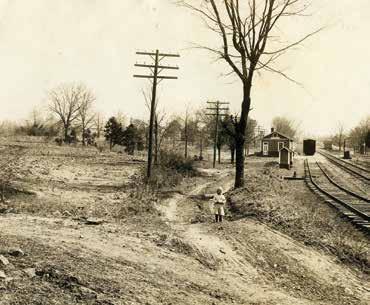
December 2024 & January 2025 Traveling





Carol Pappas is editor and publisher of Discover St. Clair Magazine. A retired newspaper executive, she served as editor and publisher of several newspapers and magazines. She won dozens of writing awards and was a Distinguished Alabama Community Journalist at Auburn. She serves as president/CEO of Partners by Design, which publishes Discover and LakeLife 24/7 Magazine®.
Roxann Edsall is a freelance writer and former managing editor of Convene Magazine, a convention industry publication. She has a degree in (broadcast) journalism from the University of Southern Mississippi, worked as a television news reporter in Biloxi and as a reporter and assignments editor in Birmingham.
Wally graduated from Auburn University where he graduated in 1976 with his BA in History and minors in German and Education. Wally’s skills in photography blossomed during college.After a 30-year career, he decided to dust off his camera skills and pursue photography full time.
David Smith aka BamaDave, is originally from Birmingham. He and his wife Renee made Logan Martin Lake their home 19 years ago. He is a freelance photographer, videographer and drone pilot. He has worked for ESPN’s College GameDay Show for the last 25 years as a cameraman and drone pilot. He has won 12 Emmys with the show and was ESPN’s first drone pilot.
Mandy grew up in and around St. Clair County with family in Moody and Odenville. She has about 10 years of experience photographing children and families, but set her camera aside to give flower farming a try. She and her husband along with their two children live in Pell City where they spend their days homeschooling, tending to the farm and flower business.
Cherith Glover Fluker, a freelance writer, blogger, and EdTech professional, holds a bachelor’s degree in English from Auburn and a doctorate in educational leadership from Samford. With her blog, WhatCherithinks, she channels her passion for self-care and travel. She has been featured in publications such as Chicken Soup for the Soul, Mother.ly, Birmingham Mom Collective, and Dollywood Insiders.
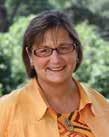



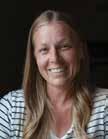

Graham Hadley is the managing editor and designer for Discover The Essence of St. Clair Magazine and also manages the magazine website. Along with Carol Pappas, he left The Daily Home as managing editor to become vice president of the Creative Division of Partners by Design multimedia company.
Elaine Hobson Miller is a freelance writer with a B.A. in journalism from Samford University. She was the first female to cover Birmingham City Hall for the Birmingham Post-Herald, where she worked as reporter, food editor and features writer. She is a former editor of Birmingham Home & Garden magazine and staff writer for Birmingham magazine.
Paul South, a native of Fairfield, is an Auburn graduate with a degree in journalism and a double minor in history. He also has a Juris Doctorate degree from the Birmingham School of Law. Although sports writing was always his first love, he had a versatile career as reporter, columnist and first full-time sports information director at Samford University.
Joe Whitten was born in Bryant on Sand Mountain. When he arrived in Odenville in 1961 to teach at St. Clair County High School, he found a place to call home. Joe was active in the Alabama Writers’ Conclave and the Alabama State Poetry Society. The society named him Poet of the Year in 2000. Joe has also published several local history books.
Linda Long has worked in communications for more than 25 years in print, broadcast, nonprofit promotion and event planning and implementation. Her writing has appeared in publications across the state. She served as news and special projects producer for NBC13 News, where her work won national, regional and state honors, including two Emmy Award nominations.
Mackenzie Free is an experienced and nationally published photographer with a bachelor of fine arts degree. She is a Birmingham native now cultivating life on a farm in Steele with her husband & 4 daughters.






As many of you know, I used to be in the newspaper business, and I have to say I enjoyed every minute of it. It was something different every day. You never knew whether you would be heading out on a Garden Club story or covering a tragic murder. Those were my reporting days.
Later, I became an editor, teaching others how to get the story but more important, how to tell it so that the reader understood its impact. I wrote editorials so that the community might have a little better insight into the issues that affected them in their everyday life.

As I look back, I realize they weren’t always glory days. Whether you report hard news or write a hard-hitting editorial, you’re bound to anger people every now and then. OK, maybe a little more often than that.
But after a long career on that side of journalism, I traded my “Scoop” hat in for that of a magazine editor and publisher, and I have to say, the vantage point is a lot rosier than those days in the trenches. And I make a lot less people angry.
I jokingly tell people “I only write happy news now,” but there’s truth to that humor. There are positives all around us. All we have to do is look. And around these parts, there doesn’t seem to be a shortage of good people doing good things to make their communities better places.
Daniella Cook of Moody saw a need, and she filled it. She loves her dog, Anki, and as Anki grew, she realized more and more how well suited she was to be a Hand in Paw therapy dog. So, Daniella went to school – and so did Anki – and the end result is their ability to help people in their most vulnerable times simply through the companionship of a dog.
Such is the case with businesswoman Renee Lilly and a group of like-minded people. They had an idea that could make their community a better place, so they created a community garden worked by volunteers that today helps feed the hungry. But their mission doesn’t stop there. They’ve created a space that provides a natural respite from the

fast-paced world around us with a walking path and bench underneath a canopy of trees.
Needs seen. Needs met.
The same holds true in Odenville, where people are still talking about the first County Fair held at the St. Clair Arena and Event Center back in October. It had a little something for everybody – livestock judging, vendors, food, entertainment and even a greased pig. It offered an opportunity for families to enjoy an outdoor festival together, get a glimpse of farm life, and it’s getting rave reviews all around.
That’s the kind of “happy news” you’ll find in this month’s edition of Discover. But, of course, there’s more. Just turn the page and discover it all with us!
Carol Pappas Editor and Publisher
Carol Pappas • Editor and Publisher
Graham Hadley • Managing Editor and Designer Dale Halpin • Advertising
Design


Renee Lilly and Rhonda Dial talk to a crowd at the garden

From
Ten years ago, Renee Lilly and like-minded people had a vision for a place where hope and fresh food grew for the food insecure.
On the old Avondale Mills property in Pell City, Lilly wanted to create a space where needy folks could learn to tend a small piece of God’s good earth and grow their own herbs, fruits and vegetables.
Two years later, Pell City’s Gateway Community Garden and its small army of volunteers moved to an acre or more of land donated by St. Simon Peter Episcopal Church across the road from the church.
The result? A bumper harvest, not just of fresh food, but of hope. The garden, Lilly said, has exceeded expectations.
When the garden began at Avondale, the hope was to inexpensively rent out plots to individuals to allow them to grow their own food. But there were few takers.
Two years later the effort moved to the church and the mission changed direction.
“We just decided, we’ll grow the food, and we’ll just distribute that food to the people who need it,” Lilly said. “Once we made that decision, everything just took off.”
Since 2018, the garden has produced more than 14,000 pounds of fresh food for county residents in need, Lilly said.
Volunteers – the number varies, but usually there is a core group of a dozen – tend, nurture, harvest and distribute seasonal fresh foods.
More have joined the effort. In fact, some 3,500 volunteer hours have been sown into the garden since 2018.
The work is vital, especially in a county where 13 percent of residents are food insecure, according to U.S. News and World Report.
Renee Lilly hands out refreshments
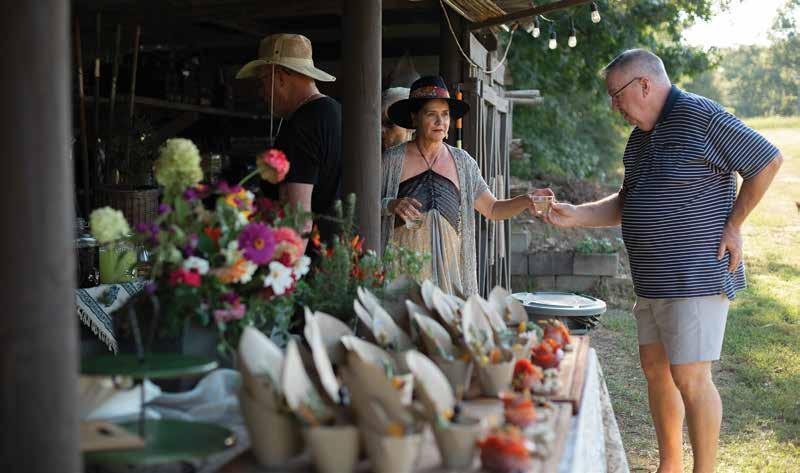
“Boy Scouts have helped us. We’ve got the Boys and Girls Clubs, and other groups have helped us,” Lilly said.
Because the garden has been so successful, and because of its partnership with the Community Foundation of Northeast Alabama, it has been designated as one of 16 “Open Spaces, Sacred Places” sites located in nine Alabama counties.
Those sites are “intended for the encouragement of community well-being and resilience of mind/body/spirit of both individuals and communities,” according to the Community Foundation of Northeast Alabama website.
“Our garden is one of those sacred spots. It’s an incredible thing that we have that here,” Lilly said.
For Lilly, certain things make the garden sacred.
“It’s a healing and restorative garden,” she said. “Not only is it a working garden where we are harvesting chemical-free food out of that garden. We also have an area in nature where people can come and sit. We have a bench with a little book library, and there’s a picnic table in the nature area where people can come and reflect on the beauty of the garden.”
The garden wouldn’t happen without the collaboration with the Community Foundation and St. Simon Peter, as well as corporate and individual support, Lilly said.
Though a secular organization, Gateway’s work dovetails with the mission of the church by feeding the mind, body and spirit of those in need. “We’re serving people,” Lilly said.
The garden’s harvest changes with the season. This fall, cabbage, kale, Brussel sprouts, broccoli and Swiss chard made up the crop. In past years, collards were a fall staple.






• Landscaping
• Hardscapes
• Custom built Pergolas
• Seawalls
• Retaining Walls
• Tree Removal services
• Stump Grinding
• Drainage Issues - French drains
• Irrigation Install/Repair
• Pressure Washing
•




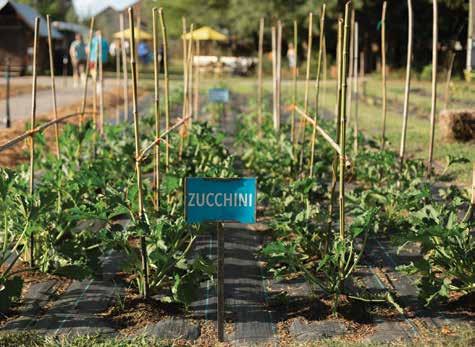

Herbs – parsley, thyme, basil and mint among them – call the garden home.
What does the success of the Gateway Community Garden say about the people of St. Clair County?
“What it says was that there was a core group of people who decided that it would be nice for Pell City to have a community garden that could take care of people in need,” Lilly said. “I think that core group of people spread the wealth, if you will, with their hard work, and more people have joined that mission.”
There is a commonality they share.
“There is a love for serving and a love for gardening.”
Recent evidence of that growth, a woman who is a master gardener enlisted her green thumb in the garden’s efforts. Some volunteers are masters, others are newcomers to putting their hand to the soil.
“We have new people coming in and joining us all the time,” Lilly said.
One of the beneficiaries of the garden is a local senior center, where food is distributed. More than once, encounters with local seniors have assured Lilly that her vision was spot on.
“A lot of times, we get to see their faces when the food is brought in,” Lilly said. “They love it. They get all excited, and they run over to us to see what we’ve brought. It’s an awesome thing.”
Lilly recalled one senior who needed food during the Covid-19 pandemic. She was driving a vanload of cabbage.
“Would you like a head of cabbage?,” she asked the man.
“I wouldn’t know what to do with it,” he replied.
“You just put it in a pan with water, salt and pepper and cook it, and it’s awesome. You’ll love it,” Lilly answered. Cabbage may have won a new fan that day.
The problems of the underprivileged are often misunderstood or dismissed outright. Lilly sometimes hears that the reason her cadre of volunteers is not as large as it could be is “because they don’t want to distribute food to lazy people.”
As the product of a broken home that faced food insecurity, she bristled at the notion.
“I’m like, ‘Wait a minute, there are a lot of people who aren’t lazy who are just in situations out of their control. I understand people who are going through a divorce or they lose a spouse, or somebody gets sick, there are all kinds of situations where people need help,’” Lilly said. “That’s why we have been distributing healthy food to people in need since 2014.”
Along with its cultivation efforts, Gateway Community Garden celebrated its third annual fundraiser earlier this month. In exchange for a $20 donation, donors were given the opportunity to win a chest freezer full of beef and pork. Chili, white and red gave extra flavor to the event, along with live music. Polly Warren prepared the beef chili and Wade Reich of the popular barbecue eatery, “Butts To Go,” prepared white chicken chili.
Back in 2014, if someone had told Lilly that the garden would flower into a success, there may have been a few weeds of skepticism.
“I would have probably said, ‘I know it’s going to take a lot of hard work. But I would have never thought that it would be the place that it is today.’”
She added, “It’s an awesome space, and we do good work there.” l



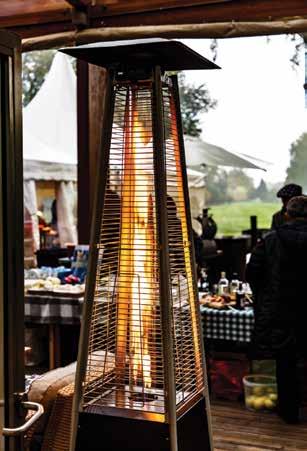



Story by Cherith Fluker
If the St. Clair County Arena and Event Center needed an exclamation point on its value to the community since its inception a decade ago, the St. Clair County Fair delivered just that.
Reminiscent of days gone by with attractions for the whole family, the fair offered a free, two-day event packed full of fun and community spirit.
Day 1 featured a vendor market, carnival rides and a petting zoo along with a Veterans Appreciation dinner and live bluegrass music. Day 2 offered even more entertainment with a car show, livestock competitions, carnival rides and the popular greased pig contest.
The fair’s finale was a high-energy performance by local band Big Country. It was an ideal way to celebrate a decade of service to the community, and plans call for its return next year.
Since 2014, the St. Clair County Arena and Event Center has grown into a hub for both the local community and visitors from across the state.
The covered arena spans 22,000 square feet and features a dirt floor. The space includes room for approximately 800 spectators, a concession stand, and restrooms with showers. It has become the ideal setting for community events of all kinds.
Over the years, the arena and event center have transformed into a destination point that hosts a wide variety of events that appeal to all ages and interests. Rodeos, barrel races,

Youths from across the area show off their animals at the arena
Children try their best to capture the greased pig

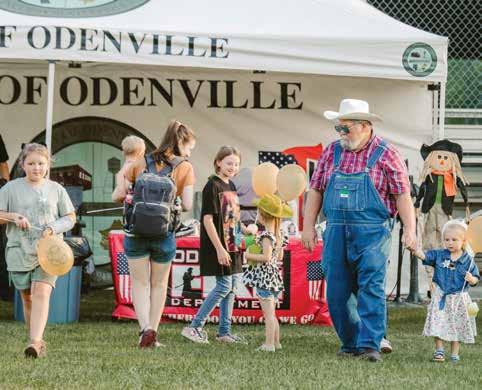

Rides, inflatables and games were part of the fun

vintage markets, dog agility shows, and car exhibitions are just a few of the diverse range of activities that draw people from all corners of the community and state. It has truly become a must-visit venue.
“The community has greatly benefited from the arena,” said St. Clair County Commission Recreation Asset Manager Ashley Hay. “By providing free or affordable events throughout the year, it offers high-quality entertainment without the need for residents to travel to Birmingham or other neighboring counties.”
The local economy has seen a boost as visitors patronize nearby restaurants, gas stations and shops. “Event hosts and spectators are encouraged to engage with local vendors, further fostering community connections,” Hay noted.
And the arena continues to broaden its community reach by hosting events like livestock shows and the St. Clair County Farm-City Banquet.
She proudly cites recent improvements to the arena, such as expanded parking, upgraded lighting and a new PA system. “We are committed to creating a welcoming and efficient environment for attendees.” The wash bay, ample parking and the ability to accommodate multiple types of gatherings make the arena a flexible and highly valued resource.
County Commission Chairman Stan Batemon shared his vision for the arena, emphasizing its role as a “respite from the busy world.” He also revealed his long-term goal to transform the facility into an agricultural hub for the county. “It’s nice that we have the event space, but we don’t want to compete








with other event spaces in our area. We want to continue making improvements and partner with schools and farmers to host events.”
The event center was built using federal pandemic relief funds, with the county contributing an additional $1 million to complete the facility. Located next to the arena, the climate-controlled center features a multi-use court that accommodates pickleball, volleyball and basketball. Open-play memberships are available for $10 per day or $100 per year for individuals, with the option to add a family member for an extra $50.
Chairman Batemon has a vision of expanding the space to include an agricultural center that could serve as a 4-H and FFA training facility. “This place could be a central location for schools to host bigger events than what they can on their campuses,” Batemon added. “It would provide a space for students interested in agriculture to learn and grow.”
Looking ahead, planned expansions, such as RV parking and additional recreational spaces will only enhance the arena’s role as a cornerstone of community life in St. Clair County. l
Editor’s Note: For updates and a calendar of upcoming events, follow St. Clair County Arena on Facebook at facebook.com/stclaircoarena.


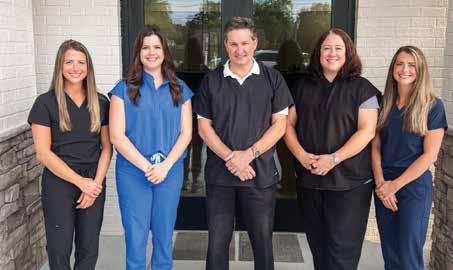

The Howard Family Holiday Farm, which opened in Moody in September, has drawn big crowds since opening day
Story by Scottie Vickery
Photos by Mandy Baughn
It’s somehow fitting that the Howard Family Holiday Farm in Moody has quickly become a go-to destination for folks hoping to create wonderful family memories. After all, the farm, which opened in September and was a celebration of all things fall before getting decked out for Christmas, is the culmination of a dream that grew from the childhood memories of owner David Howard.
“When I was 14, I told my grandmother I wanted to start a business,” Howard said. “She asked me what I wanted to do, and I said, ‘I’m going to sell Christmas trees.’” He set up a stand at a gas station at Moody crossroads owned by a family friend, Clemons Macon, and got to work.
“He had an old produce truck that sat out front,” Howard said. “I would ride the bus there and sit inside that old produce truck and do my homework and sell Christmas trees until my parents (Charles and Mary Ann Howard) came to get me at 8. My dream was that I would become a Christmas tree farmer, and it stuck with me all my life.”
Forty years later, Howard has turned that boyhood job into a way of life. And the best part, he said, is that after living and working in other places for 25 years, his dream brought him back home.
“Moody helped create the foundation of who I am today,” he said. “To be able to come back and do this and bring something wholesome and family-centered to the community is amazing.”
Although Christmas trees, wreaths and garland are getting top billing now, Howard opened the farm as a pumpkin patch. More than 5,000 visitors came through between opening day on Sept. 20 and Oct. 26, when they closed for a few weeks to gear up for Christmas.
Fall visitors could pick their own pumpkins from the patch or choose from a variety of gourds offered in an assortment of sizes, colors and shapes. The hayride was a huge hit with the kids, and the cut-your-own-flowers field of zinnias and sunflowers was a big draw, as well.
The farm reopened for Christmas on November 22, and two days later, Santa Claus arrived in dramatic fashion. He landed at the farm in a helicopter just in time for “Ice Cream Sundaes with Santa,” something Howard plans to make an annual event.
Guests had their pick of flavors, thanks to the Hershey’s Ice Cream bar located inside the farm’s country store. In addition to the 24 ice cream flavors, which Howard plans to expand to 36 next Spring, there is an array of toys, gifts and assorted jams, jellies, and other treats sold

Santa’s arrival by helicopter on November 24 is just one of many events David Howard, below right, and Gary Perkins have planned for the farm
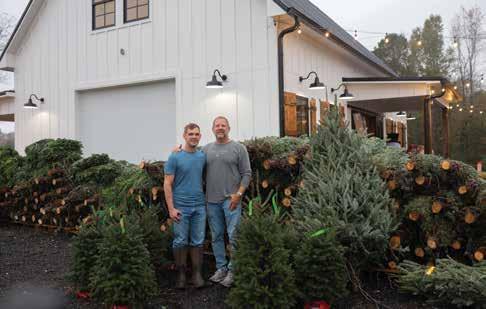
under the Howard Family Holiday Farm label, including pickled okra, candied jalapenos and peach halves.
“We have sold out of the apple butter so many times, it’s crazy,” Howard said. The peach butter, blackberry preserves and fig preserves are favorites, too, and the offerings also include muscadine grape jelly, red pepper jelly, green pepper jelly and peach preserves.
“We provide our family recipes, and a company produces it for us,” Howard said. “These are all flavors that I grew up on and helped can, pick or both.” They also offer GunRunner Gundog Honey, made by Howard’s cousin, Kenny Armstrong, a beekeeper.
The big draw now, though, is the Frasier Fir and Black Hills Spruce trees that were cut and shipped from farms in Michigan and N.C. Howard hasn’t given up on his dream of being a Christmas tree farmer, however, and he plans to plant a field of Murray Cypress trees so visitors can cut their own.
“It’s a variety of Cypress that’s specifically bred for Christmas trees,” he said. “We’re going to plant some real mature trees so we can speed up the process. We hope that in two years, we’ll be cutting 7-foot trees.”
The plans don’t stop there. They’ll take a break after Christmas and build an outdoor pavilion before reopening in March for the rest of the year. Howard said they’ll offer Alabama-grown produce, some of which will be grown at the farm. “Our first crop will be watermelons, cantaloupes, and various peppers, and then we’ll grow from there next year,” he said. “We’ll also plant Silver Queen corn, and ultimately, that will be a corn maze.”
Howard said they’ll offer seasonal potted plants and three acres of flowers, including zinnias, sunflowers, dahlias and peonies. “Folks can come pick flowers for their special events and have photo shoots in the field,” he said.
“We’re going to do anything we can that’s community-driven,” Howard said. “We’ll just see what the community will support, and that’s what we’ll morph into.”
Howard and his partner, Gary Perkins, are thrilled to be back to their rural roots. Perkins, a pharmacist, grew up on a tobacco farm in Kentucky, and they both were ready to get back to a slower pace of life.
After graduating from Moody High School and then college, Howard worked in the RV industry, in marketing and
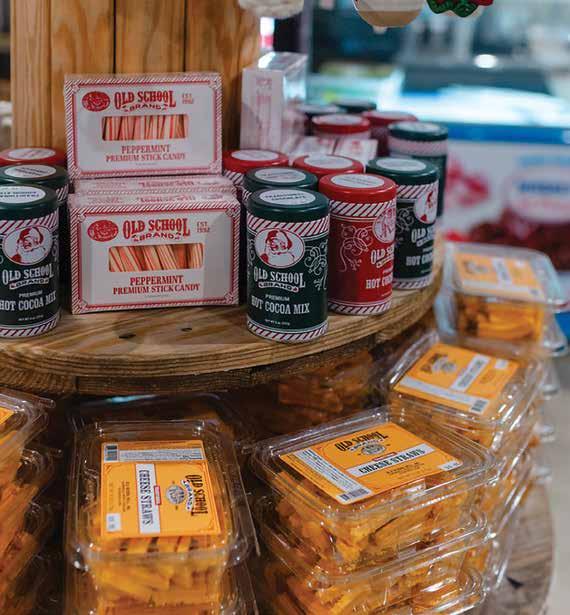
Inside the store, seasonal goodies and an assortment of farm-related toys share the spotlight with the Howard Family Holiday Farm line of preserves, jellies and pickled vegetables






The
Hershey’s Ice
Cream bar, which boasts 24 flavors, has been a big hit with customers, and there are plans to expand the cut-yourown-flowers field, which was popular during the fall
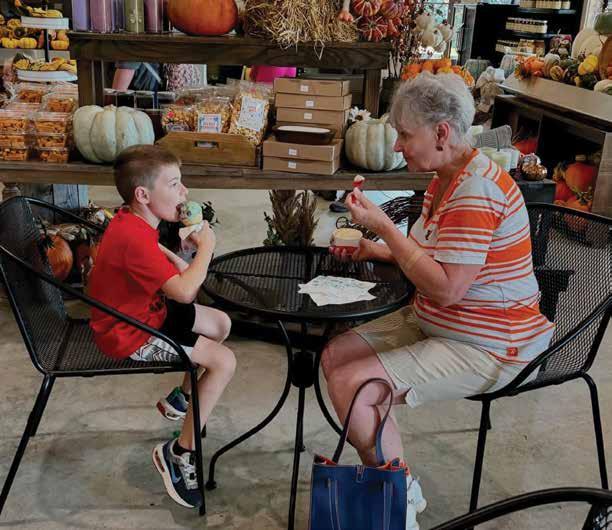
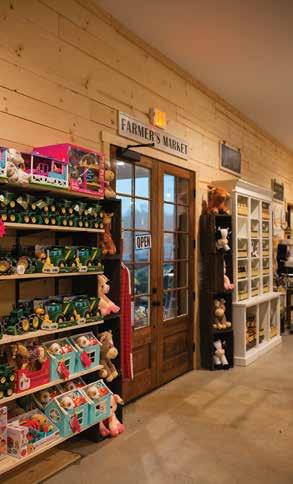

advertising, and owned a martini and sushi bar. He’s also worked in the residential construction and real estate industries. For the past 15 years, he’s owned Panama City Beach Properties, a full-service real estate brokerage company that he recently sold. “I would build five houses, keep one in my inventory of rental properties and manage properties for other people,” he said.
While he loved his career, having a heart attack three years ago at age 51 changed his perspective.
“Being faced with the possibility of something catastrophic, I felt like there is so much more for me to do,” he said. “At the beach, there’s constant tourism and everything is always ‘on.’ You can’t just go out to dinner without waiting at least an hour. Something just clicked, and I said, ‘I’m done.’ We were both done. I didn’t have to convince Gary; he was ready to make the leap to farm life long before I could get the words out of my mouth.”
Although his new venture is a far cry from the fast-paced world of real estate, Howard said he and Perkins couldn’t be happier. “We’re here to stay,” he said. “I’m back home. I think about that, and I get emotional.”
Family has always been important to Howard. “My grandmother owned multiple restaurants, and she instilled that entrepreneurial drive in me,” he said. “My first job when I was 12 was washing dishes in the restaurant because I wanted a dirt bike. When I sold the Christmas trees, I got a taste of making a few bucks, turning that into more bucks, and I was hooked. I’ve been working for myself ever since.”
Now he’s thrilled to be doing just that back home. “Moody helped shape me,” he said. “I love this city, absolutely love it. I wouldn’t have wanted to grow up anywhere else, and our commitment here is community.
“When we did this, it was a leap of faith, and we didn’t know what would come of it,” Howard added. “Seeing all the families and the smiles makes it all worthwhile. Everybody comes in and says, ‘I hope you’re successful.’ We already are, and we’re having a blast.” l





ST. CLAIR COUNTY COURTHOUSE 1815 Cogswell Avenue 100 6th Avenue Suite 212 Suite 400 Pell City, AL 35125 Ashville, AL 35953 (205) 338-9449 PH (205) 594-2120 PH (205) 884-1182 FAX (205) 594-3567 FAX
AWEATHINGTON@STCLAIRCO.COM





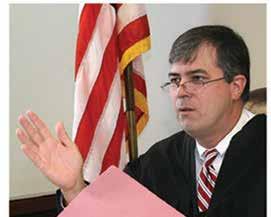






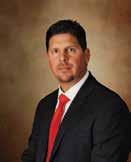














Seddon Baptist as it stands today
Story by Joe Whitten
Photos by Wally Bromberg Jr.
Submitted Photos
Today, the recreational waters of Logan Martin Lake wash over the abandoned 19th Century towns of Ferryville and Seddon.
Ferryville grew up around J.D. Truss’ ferry that connected St. Clair and Talladega Counties, lying across the Coosa River from each other.
James David “J. D.” Truss, the son of Enos and Tabitha Bradford Truss, married Martha Cordellia Coleman, daughter of William and Marannah Roberson Coleman of Riverside, on June 10, 1854.
When the Civil War began in 1861, Truss and a group of men met under an apple tree in Cropwell, and organized Company C of the 10th Alabama Infantry Regiment, with J.D. Truss as captain. Thirty-three years after the war, his obituary in The Southern Aegis, Feb. 1, 1899, told of his courage, leadership and love for his companions, but also spoke of his compassion for all people, rich or poor.
The June 30, 1876, issue of The Southern Aegis, published an unsigned letter, titled “Ferryville, Ala.” It stated that Ferryville “…is a little village situated on the banks of the Coosa River.” They listed Ferryville’s businesses as “…a carriage shop, a blacksmith shop, a post office, a good Templer’s Lodge, a Baptist church, and the dry goods house.” Post office records show that in 1868 Sylvester Coolidge served as the Ferryville Postmaster.

W.H. Cather wrote a series of St. Clair County history articles in 1897 for his newspaper, The Southern Aegis, which he established in 1872. In 1972, the St. Clair County Library Board transcribed Cather’s articles and printed them as his History of St. Clair County. One article, titled “An Indian Story,” tells of Ferryville’s connection with the Indians.
W.A. Coleman of Riverside took his fouryear-old son, Sidney, to Coleman’s father-in-law, John Roberson, to visit with his grandparents in Ferryville. By the second day, Sidney wanted to go home, and while everyone was busy, he started out.
“He had not gone far,” Cather wrote, “until an Indian by the wayside saw him and knowing him, followed him for the purpose of protecting him ... On arriving at home, little Sidney fell down on the doorsteps with the exclamation, ‘Ma, I thought I would never get to your house anymore.’ The Indian who had watched him through the forests, followed in immediately after him, and of course, there was great alarm until it was all understood.” Cather said Mr. Coleman’s eyes filled with tears when he recounted this.
Ferryville to Seddon
Ferryville flourished until the town of Seddon arose about a mile north with the completion of the Georgia Pacific Railroad in 1880. A June 6, 1942, Birmingham News article titled, “This Date in Alabama History,” tells for whom the town was named. It records that the railroad village of Seddon is “…on the Southern Railroad between Birmingham and Anniston. It was named for Thomas Seddon who … was associated with interests that financed the building of the Georgia Pacific Railroad, now the Birmingham-Atlanta branch of the Southern Railroad.”
According to Pell City Library Director Danny Stewart, “Thomas Seddon’s first job was at the Sloss in their railroad section, before he became president of the company.” Seddon died May 10, 1896, and was buried in Hollywood Cemetery, Richmond, Virginia.
The “Seddon” article in The Heritage of St. Clair County records the population as 500 when the town was incorporated (1880) and states that some worked at the “…Empire Lumber Company which operated both a sawmill and lumber yard.”
It also records that Ferryville families moved from there to Seddon.
Mattie Lou Teague Crow, in her History of St. Clair County Alabama, wrote “The first merchant [in Seddon] was J.K.P. Lacy. Dr. Harry Green Crump was the first doctor. Other settlers were Jack Maddox, W.H. and W.N. Roberson and Harvy Bell. When the timber supply was exhausted, the mills moved away.”
Today, any memory of Seddon is fading like a sepia tone photograph forgotten in the sun. However, one vibrant entity still survives –Seddon Baptist Church.
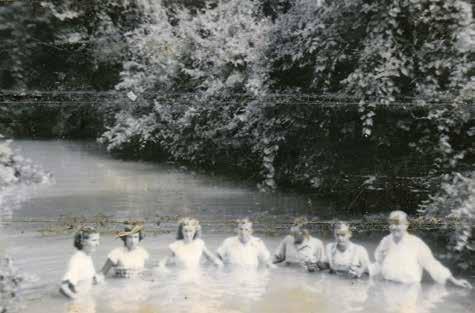











Seddon before the fire in 1996
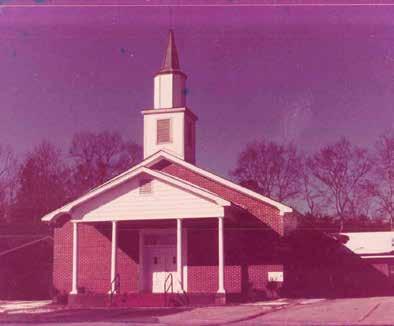
Organized in 1873 as Fishing Creek Baptist Church, the name changed to Ferryville Baptist Church in 1874. Richard M. Perry served as the first pastor.
Early records are scant, and no one knows where the members met for worship before they constructed a building. Nor is there a list of charter members. However, Stewart’s research found that Seddon Baptist sent J.D. Truss as representative, or messenger, to the Coosa River Baptist Association meeting in 1874. So, it’s probable that Truss was a charter member.
Seddon Baptist provided a first for that association in 1908, as recorded in Coosa River Baptist Association, 18331983, by Margaret Keelen Newman. “Early, only pastors of churches of the Association were given messenger status. … The most important change came in 1908 when the Seddon Church sent Mrs. Stella Brothers, Miss Minnie Crump and Miss Lenola Crump as messengers to the annual meeting. During the afternoon of the second day of a three-day meeting, the accepted messengers voted to enroll the women as messengers.”
The church didn’t send a messenger in 1909 but in 1910 sent Miss L.E. Smith and none after. Because of Seddon, other churches began sending women messengers, and in 1913 the Association agreed that “there could be no barring of anyone on the basis of sex.”
The date for Seddon Baptist constructing a sanctuary is unclear; however, the July 3, 1889, Weekly Age Herald article, “Festival at Seddon,” reports: “The supper last Friday night given by the ladies of Seddon for the benefit of the new Baptist Church was a complete success, the net receipts accounting $206.05.”
The festival also sponsored a “bouquet” contest. “The contest for the bouquet which was to be given to the most beautiful young lady was very exciting and $130.00 was raised from this. Miss Leona Fowler … received the bouquet from Mr. J.S. Lacy.” A total of $336.05 in 1889 was a grand sum. It seems this money helped construct the first sanctuary.
Singings brought together church and community. One for Seddon was announced in Our Mountain Home, Talladega, Alabama, May 19, 1909. “There will be an all-day singing at Seddon on the 5th Sunday in May. It will be a Sacred Harp

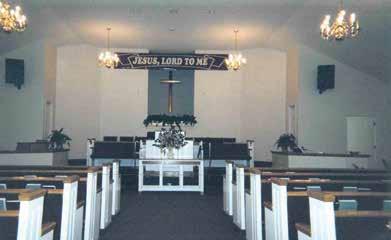
The
singing and everybody is invited to come and enjoy the occasion. The old-time music is getting a new start among the people of Seddon.” This singing was acapella because the voice itself was the “sacred harp.”
Regular worship services flourished in the first sanctuary until the demise of the town. From 1926 until 1938 there was no church in Seddon.
What caused this? The town’s economy lay in timber and lumbermills, so when the timber supply ran out, timber companies left. When the timber mills left, people left.
Jack Walker, who grew up in Seddon, recalled history he learned from parents and relatives when he wrote of Seddon’s decline.
“The clouds of a terrible depression were forming. Mills, factories, and stores were closing down. … Seddon which had been a thriving town was fast falling apart. We had a train depot, a drugstore, a general merchandise store, a grocery store, and other businesses as well as two large churches. Within a year, all these businesses were closed and boarded up. Both
churches were closed. … Seddon had become a ghost town.” Walker’s memories were published in the Georgia newspaper, Jackson Progress-Argus, May 9, 2008.
According to Betty Clements’ Heritage article, Ruby Walker was the force behind resurrecting Seddon Baptist Church about 1938. At that time the only surviving church building was the Methodist church owned by Dr. John Roberson. Mrs. Walker met with Dr. Roberson, and he agreed to let the Baptists meet in the building; however, he soon asked them to meet elsewhere.
The Heritage article relates that Walter and Leona Crump had an unused barn, which they let the congregation use for church. The Crumps emptied the barn, cleaned it inside and out, painted the interior and exterior white, replaced the barn doors with two double doors, and added entrance steps.
Inside, they installed a wood floor. “They raised the floor in front,” she recounted, “so that the men’s choir would be on one side and the ladies’ choir on the other side. In between, they built a pulpit. The lighting was kerosene lamps.”
The Crumps donated both the building and the property to Seddon Baptist’s trustees.
Linda Haynes Grantham recalled girlhood memories of this church. “To get to church, we drove over the railroad tracks and down a slight hill … Seddon Baptist Church sat on the left, a beautiful church painted white. We had a potbellied stove in the sanctuary and a raised choir loft. A huge window fan was in the window on the right in the choir loft that kept us quite comfortable – even during hot summers.
“…Brother [Lewis] Nixon was our minister and Betty Williamson Turner was our talented pianist.” Lewis Nixon was pastor from 1952 until 1957.
The church thrived during these years, with yearly revivals announced in the newspaper, as in this NewsAegis of July 21, 1955: “The annual homecoming at Seddon Baptist Church will be held next Sunday. The revival will begin Sunday night. At Sunday’s homecoming, there will be singing and dinner served on the grounds at noon. The public is invited to come and bring a basket … Rev. J.S. Williams of Pell City, evangelist.”
In the 1960s, with the completion of Logan Martin Dam and the Coosa River’s waters filling the lake, Seddon Baptist purchased land on Cropwell Cutoff Road (Hardwick Road) and constructed a brick sanctuary. A News-Aegis article of June 4, 1964, announced the dedication to be “…on June 7th at 2:30 p.m. …Bro. Paul H. Mabe will bring the dedication message.”
“The new building,” the article continued, “is valued at $27,000.00. However, the work was done by members and friends in the community, thereby saving the cost of labor.” According to the article, Cady Bryan drew the plans and was in charge of construction. Rev. J.Z. Lipham was pastor.
The first revival in this building was announced in The Anniston Star on August 31, 1963. “The Rev. Barlow Mason, pastor of Grace Baptist Church, will be evangelist for special services at Seddon Baptist Church Sept. 28. The pastor, Rev. J.Z. Lipham, announced the services would begin nightly at 7 o’clock.”
As the years passed, Seddon Baptist attendance

ebbed and flowed as was typical of many churches. Current pastor, Dale Foote, accepted the pastorate when attendance was perhaps at its lowest. “I started as pastor of Seddon Baptist Church in April 1995. That was Easter Sunday, April 16. At that time, we averaged less than ten people a Sunday,” he recalled.
A turning point occurred in February 1996, 10 months into Foote’s tenure. The church burned down. “Seddon Baptist Church Destroyed by Fire,” reported Gary Hanner in a Feb. 8 News-Aegis article. Hanner quoted Pell City Fire Chief Mike Sewell, “It appears the fire started around two gas heaters that were behind the baptistery. I saw a tint of blue in the flame and that let me know that natural gas was involved.”
Bro. Dale told Hanner, “When I became pastor, we had six people who came the first Sunday. The last Sunday we met here, we had 60 for the morning service. We’ve had 18 saved and 33 additions to the church ... We aren’t going to let this get us down. We will rebuild in the same spot. The Lord sent me here for a reason. I just want people to pray for us.”
And it didn’t get them down even though insurance covered only a fraction of the rebuilding cost. “We had $180,000 in insurance,” Foote recalled, “and the estimated cost of building back was half a million dollars. We were $300,000 in the hole.”
Campers on Mission were a Godsend for the rebuilding. “I have a friend – a general contractor – who is a member of Campers on Mission,” Foote said, “and he helped us to rebuild.”
In the March 13, 1997, issue of the News-Aegis, Anne Boone wrote of Campers on Mission in her article, “Building churches, fellowship and faith.”
She quotes Camper Bill Pilgreen., “We are Christians
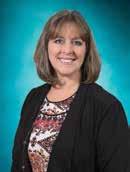











who travel to … disaster areas that need us.” Boone told of Pilgreen and his wife, who, although living in Pell City, “…set up their camper with others from their organization across the street from Seddon Baptist Church.”
Boone reported that other churches, community folk and community businesses came together to help Seddon Baptist Church in the rebuilding. Some donated food, some time and material. Cropwell Baptist provided their kitchen for preparation of noonday meals for the Campers.
At completion, the church owed $90,000 – a lot of money, yes, but far less than the $300,000 insurance didn’t cover.
The church’s Fellowship Hall escaped destruction, so the congregation met there for worship from February 1996 until December 1997. “There were weeks that we didn’t have power or HVAC or water in the Fellowship Hall because of the demolition. We had porta potties,” Foote reminisced, “and we used a kerosene heater in cold weather. We never missed a service.”
“Just before Christmas (1997), almost 40 people with active membership at Seddon Baptist held Sunday morning service inside the new church sanctuary for the first time,” Laura Nation wrote in her Jan. 24, 1998, Daily Home article, “Good will breathes new life into church.” Her article announced a revival running from Feb. 16-20 and a Feb. 28 benefit singing featuring the musical group, “Assurance.” The building dedication would occur on Sunday March 15.
With this new beginning, attendance and membership increased as months turned into years under Bro. Dale’s bivocational ministry. In 2003, attendance had grown to over 100 each Sunday and the church called him as their first full-time pastor.
“We filled that building. It held about 150, and we stayed full for years,” Foote recalled. “In 2010, we went to two Sunday morning services, and by the end of that year, we were averaging 300 in the two services.” Although the church desired to expand, the property was land-locked, and no adjacent property was available.
One day, Bro. Dale saw the “For Sale” sign at the old 84 Lumber complex on Cogswell Avenue. The property had gone back to the bank, and someone bought it. In 2010, the church located the owner and began negotiations. In 2013, the church made an offer for the property, and the owner accepted it.
The church renovated the property for a sanctuary, a children’s worship center, and a youth worship center.
So, a facility providing building materials for houses became a facility providing building materials for the soul.
On Sept. 24, 2023, Seddon Baptist celebrated its 150th anniversary. On this day, Alabama Baptist State Missionary Ben Edfeldt presented a certificate of recognition from the Alabama Baptist Association. After the service, the church family enjoyed an afternoon of fellowship, games and food.
Associate Pastor Chris Mayfield first attended Seddon Baptist in 2005 because his girlfriend, Megan Foote, invited him. He continued attending with Megan, and in 2006 he accepted Christ and joined the church. He and Megan married and are parents to two children.
Chris serves in several areas, including adults, but his main area is with children and their Sunday school curriculum. “I’ve been in children’s ministry here for a decade or more, now” Chris commented, “so I’ve had a lot of my former kids come and serve alongside me in children’s ministry.”
Chris and Megan work together in the church’s summer Vacation Bible School, an event for the entire and surrounding
Seddon train station
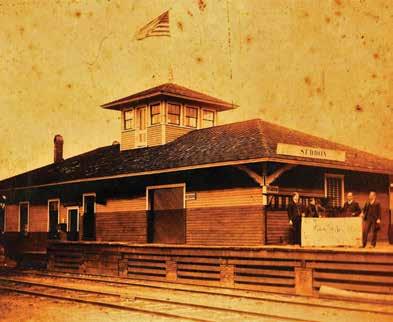
communities. “I write the VBS curriculum and lessons,” Chris said, “and right now, I’ve got about four years planned.” Megan oversees the teaching staff, music, and decorations.
According to Bro. Dale, VBS is one of the wonderful ministry events of the church. Attendance averages around 300 each summer.
Micah Kitchen is minister of Seddon Students. “We seek to encourage and equip students to live their lives to the fullest for Jesus,” he recently commented. “We are passionate about teaching students the Word of God and how to live out their lives to make the Gospel known at home, their schools and their communities.”
Kitchen and his students participate in the First Priority Club at Pell City High School. They also partner with the St. Clair Baptist Association for See You at the Pole Afterparty and St. Clair County Night of Worship. Yearly student events include Summer Camp and Disciple Now – an event where students stay at host homes, attend study sessions and spend intentional time in discipleship.
Seddon is a traditional Southern Baptist church, having a senior pastor and two associate pastors. However, it differs somewhat from other Southern Baptists in that Seddon has






both deacons and elders. “I am privileged to have Biblical elders,” Bro. Dale said. “I have five to eight men who preach here.”
Chairman of Elders Rodney Ray joined Seddon in 2008. “My wife and I saw the vibrance of the church and how the Word of God was preached. It was so refreshing that we have never left.”
Of the church being elder led, Ray said, “We kind of grew into it. As we studied the book of Acts and the Apostle Paul’s epistles, we saw that Paul’s instructions were always to appoint elders. It was plural. We have eight serving as elders, and we call it our Church Council. Three are paid pastors, and five are bi-vocational, or lay pastors.”
Each lay elder teaches a class and serves in other areas as well. Ray emphasized that members other than elders also teach classes, “… but I do feel that the teaching and preaching of the Word of God lies with the Elders.”
When asked for a comment about Bro. Dale, he said, “There’s a difference between a preacher and a pastor – someone you know was called by God and placed in that position. Dale Foote is at the top of that list. I say that because of the effect he’s had on my life.”
Today, attendance averages around 400. In 2024, the church hopes to complete a Family Life Center in their complex – a gymnasium-fellowship hall. The church serves all age groups, but the median age is 37 years. “We have wonderful senior citizen members,” Foote commented, “but we are still a ‘young’ church and have been privileged to reach young people.”
Bro. Dale’s focus for Seddon’s congregation is that they “Invite, Invest, and Intercede.” Invite someone, invest in them, and pray for them. “Our goal is to continue to share the Gospel and to make disciples,” he said recently. “That doesn’t change; every year, that’s our goal.”
Proverbs 3:5-6 is Foote’s favorite Bible passage: “Trust in the Lord with all your heart and lean not to your own understanding; in all your ways acknowledge Him and He will direct your paths.” He has seen the assurance of these verses proved true multiple times in his 29 years of serving God at Seddon Baptist.
In 1873, not only was Seddon Baptist Church organized, but Fanny Crosby’s hymn, Blessed Assurance, also was published in July of that year. Whether or not Seddon’s congregation sang it that year, we don’t know. What we do know is the assurance of Proverbs 3:5-6 connects well with the hymn’s words:
Blessed assurance, Jesus is mine, Oh, what a foretaste of Glory divine. Heir of Salvation, purchased of God, Born of His spirit, washed in His blood. This is my story, this is my song; Praising my Savior all the day long
Knowing this blessed assurance, Foote continues to trust God and His guidance as he and the elders lead Seddon in sharing the Gospel and making disciples. From 1873 to 2024 and onward, Seddon Baptist Church continues faithful as a beacon of hope in a dark world. l
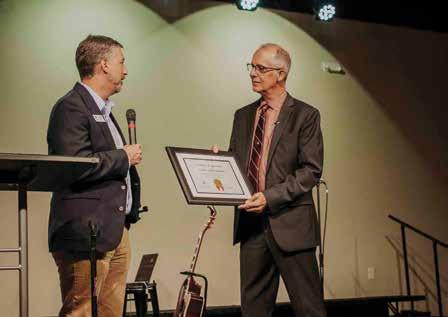




Collier St. John, 15-months-old, gives Anki a hug

Story by Roxann Edsall
Four paws, one wet nose, a wagging tail, and two expressive eyes can turn a day around. Just ask Anki, an 80-pound crème golden retriever. She’ll even throw in a full body hug to complete the comfort package.
Two-year-old Anki is a natural at her work. She and her human, Daniella Cook, serve as ambassadors for Hand in Paw (HIP), an organization that offers animal therapy in the Greater Birmingham area.
When Anki was just a puppy, Cook’s veterinarian commented that she was exceptionally calm for her breed. Later, as they attended puppy obedience classes, the instructor commented on how she seemed like an “old soul” in a puppy body.
“Then a cycling buddy of mine asked me if I’d ever heard of Hand in Paw,” said Cook. “Anki was just six months old at the time and the minimum age for a dog is 18 months to be a part of that organization.”
So, Cook used the next year to research the steps to becoming a therapy team for Hand in Paw. Successfully completing obedience classes was just the first step. “We went on to take a Good Citizen dog class,” said Cook. “There are 10 benchmarks you must meet and if you miss one, you’re out. She got them all, despite it being an adoption day at the pet store where she performed for her final Good Citizen evaluation.”
Cook, who works in Pell City at WKW, a German company that supplies auto parts, occasionally brought Anki to work with her. She noticed the effect her dog had on others around her. “We had a plant manager who had had a really rough day,” Cook recalls. “He asked if he could hug her, and in five minutes you could see a difference in him. He asked if I could bring her in once a week.”
At 18 months old, Anki was ready to be evaluated to partner with Cook as an official therapy team. Stephanie Stoltzner is the volunteer and program manager for HIP. “We take them through a four-week workshop, then evaluate them to make sure they can deal with outside influences and the many things that can happen in the environment they would be working

in,” explains Stoltzner. Anki and Cook passed with flying colors and received their new uniforms – a bright yellow bandana for Anki and a matching yellow shirt for Cook.
Cook’s face lights up as she shares details of some of the animal therapy experiences the pair have been party to. Recently the duo was sent to the Exceptional Foundation in Birmingham, an organization that provides social and recreational services for adults and children with intellectual disabilities. Cook and Anki were positioned in the center of the room, and each person had an opportunity to interact with the beautiful pup and her owner.
“On this day, there were all adult clients,” recounts Cook. “When they saw Anki, their faces lit up, and they talked about their own dogs. One client told me how she trained her dog and asked if she could train Anki. Anki leaned into her in a hug and just made her day. I still get goose bumps thinking about it! I was just so proud to have this dog and to be able to make a difference.”
Cook and Anki are the second HIP team from St. Clair County. Kelli Agnew and her seven-year-old corgi, Tessa, have been a busy Hand in Paw team for over two years. This is Agnew’s 13th year as a volunteer for HIP. Tessa is her second therapy dog.
Her first pet therapy partner was a Pell City animal
therapy moments involved Asher and a visit to a memory care facility. “We were visiting with a lady who would not speak; she hadn’t spoken since she’d been there,” Agnew remembers. “This lady was so happy to see Asher and started making happy noises to this cat. The nurses were shocked that she was communicating with him.”
After Asher passed, Agnew spent five years as a Hand in Paw team with her corgi, Oliver, working with the child and adolescent psychiatry unit at UAB. They also participated in the organization’s delivery of the Sit, Stay, Read! program, an animal-assisted reading program for early education. This program has shown great success in encouraging reluctant readers to read to an animal companion.
Five years after Oliver passed, Agnew adopted Tessa, another corgi, this time a Pembroke Welsh and former show dog. Having had experience with the animal dispositions that make for good therapy pets, she saw something special in Tessa. “You could tell from the beginning that she was going to be a great therapy dog,” said Agnew. “You take her anywhere, and she instantly goes to people. She just loves everybody.”
It’s that temperament that helps deliver effective animalassisted therapy. In a 2008 study by the National Institutes
We appreciate your business and wish everyone a happy and safe holiday season. We will be closed the last two weeks of the year to let our staff enjoy the holiday season!




• Legends Boat Show January 24-26, 2025
• 3198 Speedway Blvd, Lincoln AL 35096
• Free Admission, Live concert Saturday night with Deputy Five Come See Us at The Boat Show in January!

Need to prepare for next season? Got a big job? Book your work today and get discounted

of Health, human interaction with pets was shown to reduce stress, improve mood, lower blood pressure and to reduce anxiety.
In 1996, Beth Franklin, a Birmingham native and animal advocate, started Hand in Paw to improve the health and wellbeing of people through interaction with pets. She was serving as executive director of the Greater Birmingham Humane Society and worked with juveniles who were serving courtmandated community service.
Intended simply to provide help to animals in need, the program had an unexpected benefit. Franklin was struck by the positive behavioral changes to the volunteers because of their interactions with the animals.
In the 28 years since its founding, Hand in Paw has become a national leader in the growing field of animal-assisted therapy. They now have 92 owner/pet teams, who go out to a variety of intervention sites, including universities, hospitals, nursing homes, veterans’ homes, schools, physical therapy facilities, hospice and respite care and libraries. They also offer first-responder decompression visits.
“We’ve been to the Birmingham Police Department during shift change,” said Cook. “I’ve seen officers get down on the floor with Anki. They come by to say hello as they’re leaving to go home and as they are arriving for shift.” Agnew and Tessa spend some of their volunteer time working with clients at the Bruno Cancer Center, Girls, Inc., and at Lakeshore Foundation.
Stephanie Stoltzner has been working with Hand in Paw since long before she worked there. She has a team of two dogs, Olive, a mix who looks like a golden retriever and Fern, another mix, who Stoltzner describes as looking like “she stuck her tongue in a light socket.” Their greatest reward as a therapy team, she says, is the people. “It doesn’t matter how bad a day I’m having,” she says. “I see the pure joy and happiness people get from seeing the dogs. Now I work here and get to work with my dogs all the time. it’s a dream.”
Anki and Tessa know that when they get bathed and fitted with their yellow bandanas, it’s time to go to work. Both Cook and Agnew say they seem to know they’re “on” and take matters seriously.
Spreading joy and encouragement is serious business. Paws down. l
Editor’s note: Hand in Paw is a 501(c)3 nonprofit and survives on donations and grants. There is never a charge for their services. If you are interested in working with them or helping with their mission, contact Hand in Paw at handinpaw.org

Daniella with Anki, her “middle child”, Bella (almost 12), and Willow, a half Great Pyrenees and Golden, who is 1

Tessa, the Welsh Pembrook Corgi, greets Collier









Story by Elaine Hobson Miller
Photos by Mandy Baughn
When Mike Jones’ great-great grandmother, Euphrasia Hannah Gibson, died in 1874, she left a box of quilt squares that she had intended to sew together. She probably had no idea those squares would someday hang in the homes of future generations, much less be replicated on wood and hung on a barn in Cropwell.
“My grandmother had the box of quilt squares, and when she died 15-20 years ago, her daughters rediscovered them when they cleaned out her house,” says Jones. “They got together and passed them out to each of the 14 cousins. So, we have had them that long. My daughter, Kristina Alexander, has one, too. I’m not sure who has the rest of that box of squares.”
Kristina’s daughter, Jules, was 16 when she translated her 4th-great-grandmother’s quilt piece to a wooden board during the summer of 2023. Jules’ mom did the math and figured out how to enlarge the quilt block pattern to scale for a 6-foot-2.5-inch square piece of plywood that Mike cut for that purpose.
She put a screw in the center of the board and tied a string to it to make a compass, then used geometry to figure out the ratios. That was after Mike had painted three layers of a white base coat onto the board. Jules used a pencil

Holding their quilt squares in front of the Jones barn are cousins Joy Sanford, Kathy Callahan (standing in for husband Jimmy), Walter Jones, Mike Jones, Michelle Dowler (for her mom, Gayle Boone), Karen Ragsdale, Christy Robbins (for her dad, Don Callahan, deceased), Carol Tucker, and Quinn Stewart (second oldest cousin at 83)
A Jones Family scrapbook displays a photo of Euphrasia Hannah Gibson (woman on right-hand page), among other family members

to draw the design, a Dresden Plate with a star in the center and some extra colors in the corners.
“It took me a good while, because I had lots of coats to do,” says Jules. “I had to tape off each section to get clean lines. My grandfather picked the colors. He wanted something fall but bright and festive.”
Jules has been involved in art a long time, and usually prefers working with watercolors. She has painted stationery for friends and family, and helped groups from her church, Pell City United Methodist, to paint murals in a local private high school. “So, when my grandfather asked me to do this job, I was excited.”
The quilt squares are about 180 years old, according to Mike’s wife, Sandra. “The blocks were given to all the cousins in Mike’s generation.”
On Aug. 31, most of those 14 cousins gathered at the Jones House to celebrate Labor Day and compare their quilt squares. Each one features the same Dresden Plate design, but in a different color palette. Some have framed theirs, others haven’t yet. Each is proud of the heritage, though.
The Joneses hope their barn quilt will become a part of the Alabama Barn Quilt Trail. An agricultural tourism project, the Trail is designed to promote travel and community pride by encouraging the public to explore the state’s roads, farms, businesses and historic towns, according to its website. “Barn Quilts are part of what has become known as ‘The American Quilt Trail Movement,’ featuring colorful quilt squares painted on barns and buildings throughout
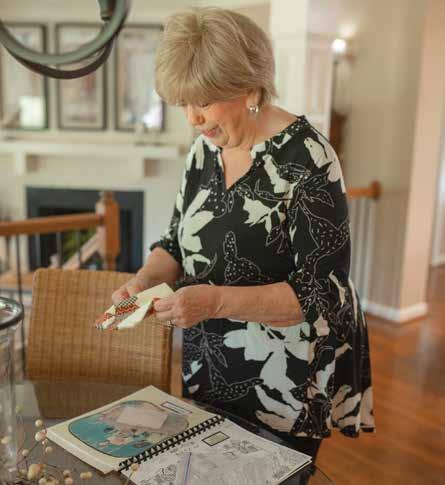

Kristina Alexander is proud of the quilt piece her parents passed on to her from her dad’s great-greatgrandmother
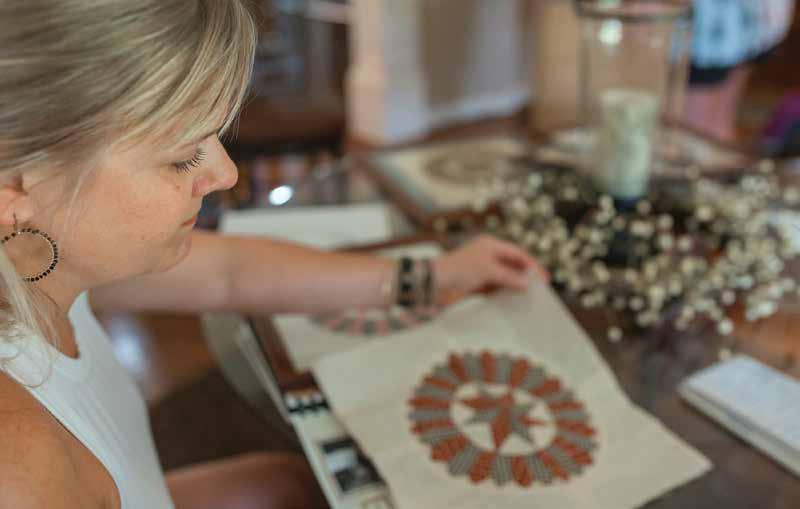

North America,” the site states. “It is one of the fastest-growing grassroots public art movements in the United States. Tourists come to discover the quilt squares on thousands of barns and buildings scattered along driving trails throughout the nation.”
Regina Painter founded the Alabama Barn Quilt Trail in 2015, primarily in five northwestern counties of the state because of grant money from the Northwest Alabama Resource Conservation & Development Council. “We are very concentrated in north Alabama, but now have grant money from the Alabama State Council on the Arts to cover the entire state,” she says.
A fabric quilter herself, Painter saw her first barn quilt at a quilt show in Tennessee several years ago. “I fell in love with the idea and wanted to see them in Alabama. So, I started the Alabama Barn Quilt Trail with assistance from several groups and individuals.”
By registering with the Trail, a person encourages agritourism and promotes small communities across the state as visitors check out the beautiful quilt blocks and their settings, Painter says. “We promote the Trail with brochures, public presentations, social media and various television and printed publications.”
The organization will help anyone pick out a design and colors, and will register a barn quilt for the trail after forms available on the site are







filled out and turned in. (See alabamabarnquilttrail. org). If, like the Joneses and at least half a dozen others in St. Clair County, you have already painted your quilt, you can still get it added to the trail. Interested barn owners may contact the organization by email (alabamabarnquilts@gmail. com)
According to the website, the benefits to communities and their small businesses include:
Providing an economic benefit from tourism for businesses and farms on the Quilt Trail
Promoting preservation of our historic barns
Honoring the agricultural roots of the State of Alabama
Creating public art and paying tribute to the uniquely American history of beautiful quilts. The trail is supported by the Alabama State Council on the Arts, ALFA and the Alabama Farmers Federation.
Of the 204 quilts on the state trail, seven are located in St. Clair County. In some cases there may be more than one wooden quilt registered. The Ashville House of Quilts in downtown Ashville, for example, has three designs. Greensport Marina has one, and one of the marina owners, Beth Evans Smith, has three others registered at various buildings on Greensport Road. The Trousdale Family has three blocks at 22630 U.S. Hwy. 411 in Ashville.
A barn quilt at 4522 County Road 22 is registered to Mark and Emily Taylor of Ashville. But it actually belongs to Emma Bean, the granddaughter of Emily’s deceased sister and husband, Doris and Billy Bean.
Painted in 2022, Grandmother’s Flower Garden is the name of Emma’s quilt square. “This
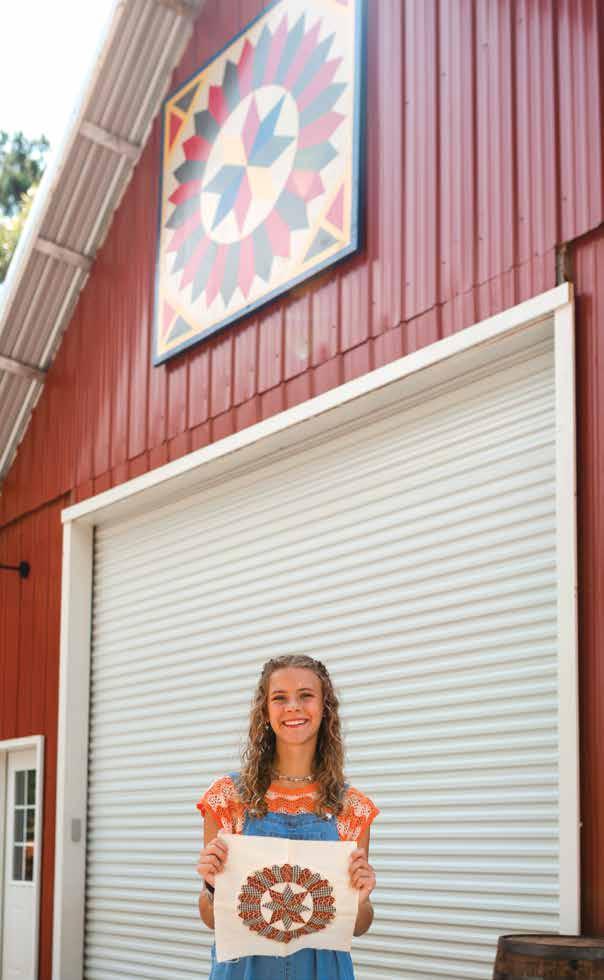
Jules Alexander, 17, painted the quilt square for her grandparents’ barn using the piece they inherited from Mike’s great-greatgrandmother
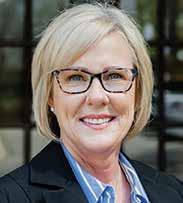





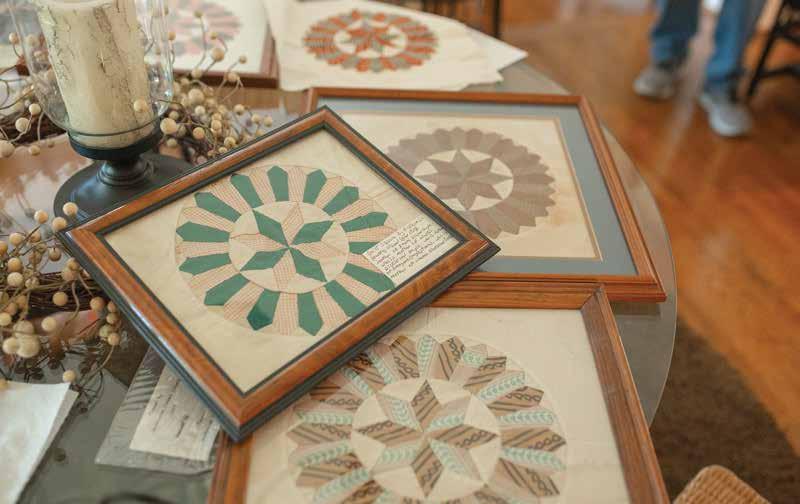
was her grandparents’ barn,” says Mark. “An Alabama Barn Quilt Trail crew drew the quilt pattern.” Father and daughter, Nathan and Emma Bean, along with other volunteers, painted it. The barn and the land it’s on was passed down to Emma from her grandparents.
“We have some at my business, Taylor Fence, at 4097 County Road 22, and at our home, 9463 County Road 31, both in Ashville, but they are not registered on the Alabama trail,” Mark says.
Quilter Joyce Foster, who lives on Belvedere Drive in Ashville, doesn’t have a barn and didn’t fancy mounting a large board on her garage, so she attached her 10-by-10-inch quilt square to her mailbox post. “It’s no particular design,” she says. “I just drew some lines on a piece of plywood and filled them in, then painted it. I think that was about four years ago.” l
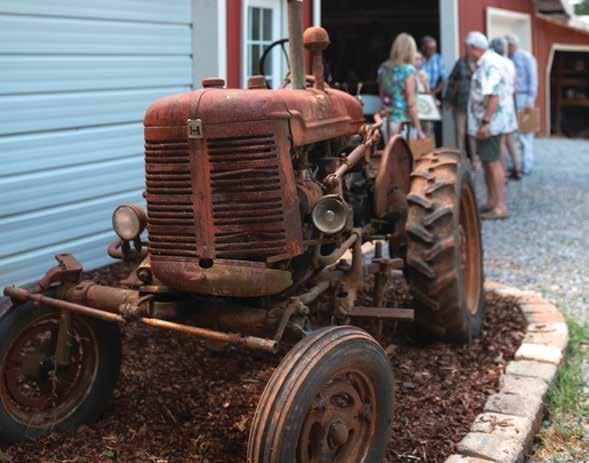





Happy Holidays!
Story by Paul South
Photos by David Smith
Submitted photos
The legendary South African golfer Gary Player may have said it best when it comes to golf and friendship: “In golf, as in life, it’s the friends we meet along the way that make the journey worthwhile.”
No place does Player’s words ring truer than at Pell City Country Club St Clair County’s only golf course. The 6,100-yard, semi-private layout has forged many friendships over the past 63 years.
Now, the club aims to make new friends by bolstering its membership and by promoting itself as an event venue for wedding receptions, birthday parties, baby showers, graduations, and holiday parties in its newly renovated clubhouse.
PCCC was started in 1961 by a group of prominent local businessmen weary of driving to Talladega to play golf.
Dr. Raymond F. “Bam” Cox, Kenneth Tucker, Howell Henderson, Hank Harmon, Judge Edwin Holladay, Forest Walls, J.T. Holladay, Dr. John E. Haynes and Roy Coshatt started the club. Tucker sold the 85 acres where the golf course resides on Golf Course Road.
“It wasn’t like today when you bring in a prominent golf course designer such as Jerry Pate (a former U.S. Amateur and U.S. Open champion) to come in and design the course,” said PCCC board member Jeff Ingram who “grew up” on the golf course. This group of men came up with the idea to build a golf course they could play and be proud of. The golf course is basically the same course as it was when it was built in 1961.
Through the years, the course and clubhouse have weathered numerous storms and a declining membership. Pell City officials even fought off an effort by the City of Birmingham to take over the course to create a satellite airport to what is now the Birmingham Shuttlesworth International Airport.

The course


The golf course was opened to public play approximately 15 years ago. “That’s one thing that helped us survive,” Club President Derrol D. Luker said. “There weren’t enough younger people joining the club to replace the older members who had quit playing or passed away. The public play has really helped things out.”
According to unofficial club historian Roger Pate, retired principal of Pell City High School, PCCC has attracted more than its share of champions, including UAB standout and 2012 U.S. Open champion Graeme McDowell of Northern Ireland, 3-time PGA tour winner Boo Weekley, and former local PGA tour player Will Wilcox.
PCCC also is home to Chris Spivey, who has won numerous women’s state amateur titles over her career, and it has hosted football standouts Jay Barker and Bobby Humphrey and NBA star Charles Oakley. Those are some big personalities for a small-town course, especially a “nine holer,” said Pate.
The club has a pro shop as well as a small practice area and putting green. It is a nine-hole course with two sets of tees. Each hole has a set of white and blue tees for men less than 60 years old, yellow tees for men from 60 to 70 years of age, red tees for men over 70 years of age and women of all ages. Greem tees are for players 75 years of age and older. The club currently has 80 members.
On Mondays, Wednesdays, Fridays and Saturdays, the course hosts an 18-hole “dogfight,” basically a mini
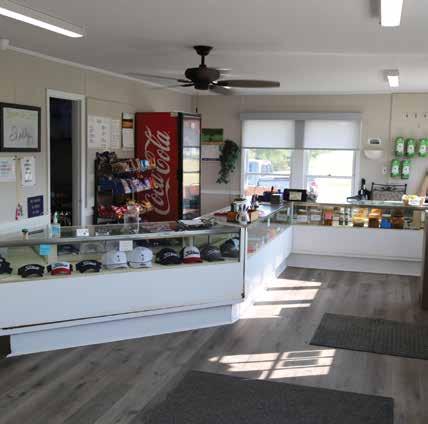






tournament filled with fun and fellowship. In past years, when Pell City shut down at noon on Wednesday afternoons, as many as 50 golfers played in the dogfight.
“As far as the course, I think the reason people like it is it’s a shorter course, and it doesn’t take a long time to play. I think that’s what makes it a little special. You’re there to play golf with your friends,” Ingram said. “It provides something for the town that doesn’t exist anywhere else in the county.”
But it’s the people, not pars that make the club special. Many of the members were born and raised in Pell City and learned the game as kids on the course.
“The camaraderie and growing up with the members,” Ingram said. “As you get older, you’re playing with the same people you were playing with many years ago. It’s a smaller club. You don’t have as many members. You can put a name with a face. You’re not a number like you might be at a larger club.”
Pate agreed. He’s been a member since 1971 and serves as course superintendent. “It’s the people,” he said. “We have a lot of fun.”
Small country clubs like Pell City have struggled in recent years to keep members amid stiff competition for the entertainment dollar. But the coronavirus pandemic and the raging cabin fever that came with it sparked renewed interest and attracted new members to the club.
“The numbers of rounds have definitely gone up since COVID first came around, and the number of rounds played have increased every year since COVID came,” Ingram said.
“Before COVID, we were really hurting,” Pate said. “It’s grown since then. A lot of people didn’t know this golf
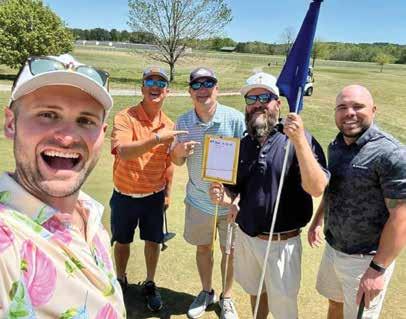
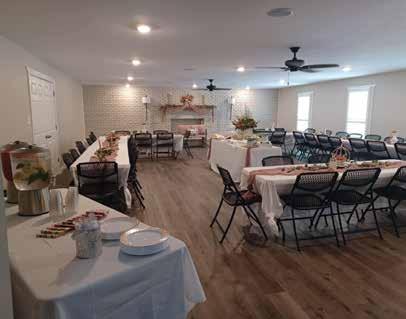
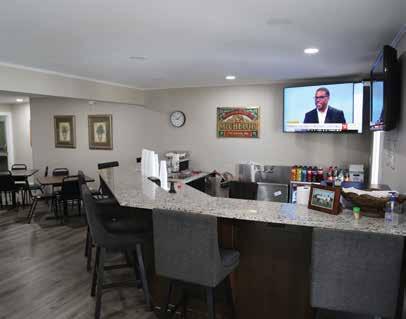

course was here. It’s kind of off the beaten path.”
As with Pate and Ingram, the club’s warm, welcoming membership makes PCCC a special place to belong.
“You can go down there almost anytime and find a game,” Luker said. “There are just good people down there.”
Any discussion of PCCC would not be complete without mentioning the late Ray Cox. While Ingram has fond memories of winning numerous tournaments with Ray over the years, the deeper memories are of Cox, the son of one of the co-founders and also a past president of the club until his death in 2007. The founder of Metro Bank, Ray Cox played at PCCC “from day one,” Ingram said.
“He played golf all over the world, but PCCC was his favorite course,” Ingram said of his late friend. “I promised Ray before he died that as long as I was able, I would do my best to keep the doors open. So far so good.”
Luker was one of those kids who grew up at PCCC. A third-generation member of the club, he holds fond memories of playing with his Dad. But he, too, remembers Cox.
“Before I was even 16, we lived in Mays Bend, and my Dad would let me drive over to the golf course by myself on Sunday mornings to take golf lessons from Mr. Cox.”
Cox taught young Luker, now a land surveyor, a valuable lesson. “Patience,” Luker said.
“He was a role model to Jeff and myself,” Luker said. “We want to keep his memory going because he meant so much to the club and to Pell City.”
The longevity of the club is based upon the people, the friendships and chance to compete.

A membership at PCCC costs $100 per month with no initiation fee at the present time.
PCCC has a newly remodeled clubhouse to host special events that can accommodate up to 120 people. Costs vary depending on the number of guests, season, and time of the event. Costs range from $350 to $750.
PCCC is located at 2021 Golf Course Road in Pell City. Learn more about the club on its Facebook page, or call (205) 338-2066 to learn more about tee times, club membership or plan an event.

Story and photos by
Graham Hadley
a
When Jason and Danny Kellner first considered opening an antique mall in historic downtown Pell City, they knew they had a good chance of making it work because they already had almost a decade of success with a similar venture in Anniston – Kolectic Treasures Antique Market.
They just needed to find the perfect location.
They found it in the old roller-skating rink and adjoining Maytag building next to Brittle Heaven on Cogswell Avenue. And the second location for Kolectic Treasures is going to be even bigger than the Anniston store.
“We have around 19,000 square feet in Anniston, and this one will be 20,000 square feet,” Jason said. “We live on Logan Martin and saw Pell City as a good fit for what we wanted to do.”
Jason and Danny’s vision for the antique malls is almost unique in the business. They not only want to have a wide variety of “treasures” to sell – from rustic country pieces to midcentury modern – they want to make finding those something of an adventure.
Anyone who has visited the Anniston location will be familiar with the concept.
“I worked really hard in Anniston to build it,” Jason said. “I wanted to come up with something different from other antique malls. I have a mental image of a maze, you are exploring it, there are lots of twists and turns. I want our customers to feel like they are going back in time, get lost for a minute away from the stresses of the outside world.”
The Kellners have filled the two buildings with a series of booths and passages that wind and twist their way through the structures, which share an adjoining wall that has been opened across the front to allow access to both from one entrance. Customers find something new around every corner.
“We have something for everyone. That’s kind of my motto,” Jason said.
That idea has served them well in the Anniston location, which they created out of an old strip mall off Alabama 21 next to the bypass.
“I got in there and expanded as more customers found us.”
When Jason and Danny first saw the old
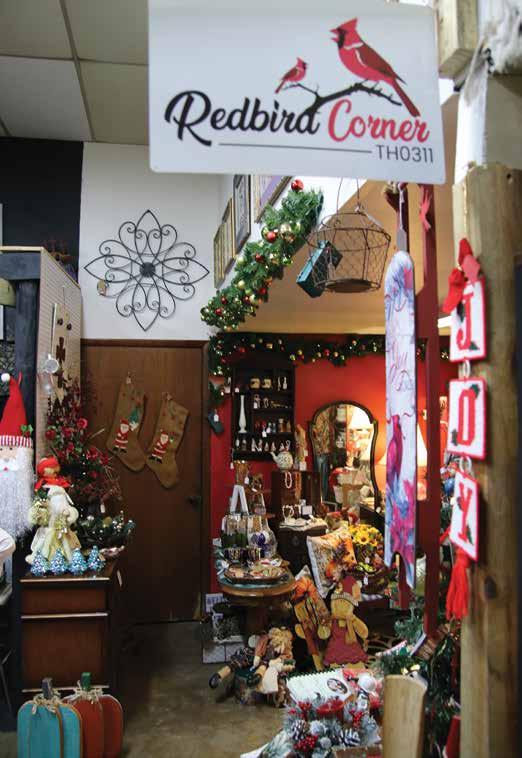
A variety of vendors are already in the location with more than 100 more on the way
buildings, owned by the DeGaris family, they knew they had found the perfect fit for their plans. In only six weeks, they were able to recondition the structures, which had been used for storage of all kinds of local artifacts for years, build out most of the booth spaces, and have a soft opening with around 100 vendors already in by Nov. 4. There will be room for 275 vendors, many of whom are already lined up, by their grand opening, Dec. 13.
“That is the day of the parade. We will also have our Christmas Open House the same day and will be staying open later so people can stop by after the parade,” Jason said.
“We want to bring something really special to Downtown Pell City. We hope to bring more customers and more foot traffic to the area. We want to see the same level of business here that we see in Anniston.”
They are working on remodeling the exterior of the buildings, while keeping the important historical features. “We want it really rustic looking – keep the old style and make it new at the same time. We want to get our signs up, but also want to get the old Maytag sign working again. We want to replace all the old glass, make it look almost like an old-English style, and repave the parking lots. It’s going to look really pretty when it’s all done.”
And this is just the beginning of what he envisions for their Pell City location.
“We have room on the property to expand the market by around 3,000 to 4,000 square feet in a year or so as our customer base grows, if people shop local.” And like their Anniston location, they want to have a little library and food bank boxes next to the parking area. They have held successful music festivals at the original store for years, something Jason is considering doing in Pell City, along with showing movies on the adjoining property.
The Kellners are already familiar with their nextdoor neighbor – Brittle Heaven and More. Owner Sarah Deese used to sell her peanut brittle and other goods out of Kolectic Treasures in Anniston.
“She started with me in our Anniston store and eventually wanted to open her own location here. We were both excited when we found out we would be next to each other,” Jason said.
She is not the only one who has made the owners of Kolectic Treasures feel welcome in Pell City.
“People are excited about us being here, and we are thankful to everyone who has helped us. The Chamber has been really phenomenal with all the support, so has the City and the DeGaris family,” Jason said. “Danny and I have worked really hard to make this happen. We are just very happy to be here.”
Editor’s Note: You can follow Kolectic Treasures on Facebook and their website at kolectictreasures.com.
The Maytag and skating-rink building exterior before renovations got started


helped the DeGaris family sell off the huge collection of antiques stored in the buildings

Today the space has booths for customers to explore














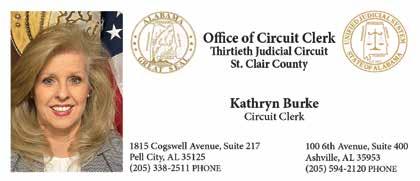


























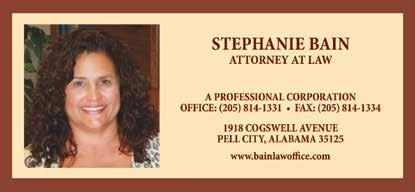

Story by Linda Long Staff and archived photos
St. Clair County is at it again. Fiscal 2024 is shaping up as another banner year – like the one before it and the one before that. Despite inflation, run amok, threats of a recessionary economy and an uncertain election year the county continues to chalk up impressive economic numbers, showing an upswing in new investments especially in manufacturing, and a surge in retail expansion.
Don Smith, executive director of the St. Clair County Economic Development Council (EDC) called 2024 a “positive” year for the whole county. “We had 10 large projects that we either broke ground or announced plans for expansion. These 10 projects represent a total of 343 new jobs and over $117 million in new investment,” said Smith.
According to Smith, high on this year’s economic agenda is implementing the county’s new 5-year strategic plan with renewed focus on helping St. Clair communities transition from small towns to the suburbs. The county’s Grant Resource Center is playing a vital role in helping with that transition.

As Smith explained the county has a new strategic plan in place every five years, but he was quick to note, “the plan is not what we (EDC) think, but rather a consensus from hundreds of people – business leaders, elected officials, community leaders – people who come together at three different events to get a full picture of what the vision is for St. Clair County.
“From those hundreds of people, giving us their expert opinions,” Smith continued, “we’re able to formulate what it is we need to focus on for the next five years “
The current plan was released the first of the year, and certainly part of its focus is to help St. Clair’s small towns make that critical transition from rural to suburban.
“This is showcased with the creating of our new Grant Resource Center that will provide the County Commission and all the municipalities with the knowledge of funding opportunities as well as the tools in which to apply and be awarded grants needed for many of the needs of a growing community,” Smith explained
Some of those needs include “water, sewer, transportation – in a word, infrastructure. We need those things so we can bring in more employers,” he said. “So, we can bring in more retailers. That’s why the strategic plan is calling for an entity to assist our communities obtain different grants that are out there – federal, state and regional.”
As Smith explained, every single dollar a community can raise in grants is a dollar that doesn’t have to be taken from what Smith called “hyperlocal” expenses.
“Most cities in Alabama don’t have anything like this,” he continued. “It’s a valuable resource. So far, the new Grant Center has helped secure $6.5 million in outside funds that would normally have to be paid for with local funds. This money is coming in from different grants that have been written, and we’ve already been approved for. The more money we can obtain from these grant sources, the more the local dollars can be put toward local needs.”
One such project was the purchase of 250 acres on the I-59 corridor. Smith said that property will soon be developed to attract large, quality employers to add to the ones already in that area. “These new companies will employ our citizens, raise the average buying power of the community and generate more taxes for our cities”
St. Clair County was the fifth fastest growing county by percentage in 2023. “This growth,” said Smith, “requires long-term planning and a larger investment in infrastructure. We are working with our elected officials and providing resources to help them manage the increased demands that come with this growth.


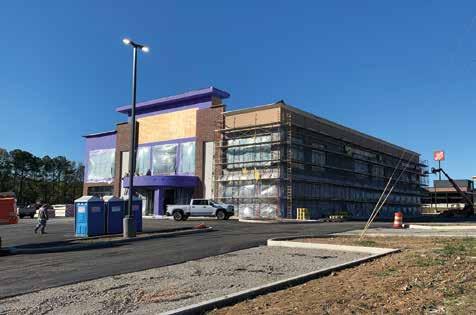

The City of Ashville has been awarded the prestigious “Alabama Communities of Excellence” designation, joining only 45 other communities across the State of Alabama.
The recognition was presented at the 2024 Graduation Ceremony hosted by the Alabama League of Municipalities, celebrating Ashville’s commitment to sustainable growth, economic development, and enhancing the quality of life for its residents.
The “Alabama Communities of Excellence” designation highlights Ashville’s strategic efforts in community planning, fostering local business development and prioritizing initiatives that make Ashville a vibrant, welcoming, and resilient place to live. This honor underscores Ashville’s dedication to maintaining high standards in community excellence and its proactive approach to ensuring a prosperous future for the city’s residents.
“Receiving this designation is a tremendous honor for our city and a testament to the dedication of our residents, city staff, and local leaders who have all worked tirelessly to make Ashville a great place to live, work, and visit,” said Ashville Mayor Derrick Mostella. “We are proud to be recognized by the League of Municipalities and will continue to prioritize the needs of our community as we look to the future.”
St. Clair County Economic Development Council Director
Smith shared his excitement, saying, “This designation is a well-deserved recognition of the hard work and vision demonstrated by the City of Ashville’s leadership. By earning the Alabama Communities of Excellence title, Ashville has positioned itself as a model for sustainable growth and community development across Alabama.”
The Alabama League of Municipalities’ program, which awards the Communities of Excellence designation, identifies municipalities that are proactive in creating and implementing projects that positively impact their communities and align with the League’s vision of excellence in local government.
In addition to the city’s Communities of Excellence designation, Candice Hill, the St. Clair County EDC’s Grants and Leadership director, received the esteemed ACE Star Ambassador Award. This award honors her dedication and leadership in guiding Ashville through the process, ensuring the city stayed on track to reach this notable achievement.
EDC officials say they look forward to seeing the positive impact this designation will have on Ashville and commended the city for its dedication to fostering a thriving and supportive community environment. This achievement is a reflection of Ashville’s commitment to ensuring that future generations benefit from the city’s progress, infrastructure improvements and economic opportunities.
•
•
•



• GED preparation
• ESOL
“When my mother had the beginnings of dementia, she was in Birmingham, and I was in Pell City. Working full time, I couldn’t be there. But Always There could, and they helped her with the things she needed to remain independent -- taking her grocery shopping, making sure she got the right medications at the right time, being a companion. Always There allowed her to stay in her own home and took the worries away from my siblings and I when we couldn’t be there for her.”
-- Carol P.
• Companionship • Bathing and Grooming
• Care Management • Dressing
• Errands
• Escorts for shopping
• Laundry and appointments
• Light Housekeeping • Meal Preparation






Life through the lens of Mackenzie Free

One day the lens of retrospection will come into focus, and we will see clearly the beauty and redemption that was woven into our darkest days.
Those times we most struggled – when our faith was tested, our hearts were broken or we felt lost and defeated by the harsh realities of life ... we couldn’t see all the light that illuminated us then because we were so consumed by the shadows.
We have heard it before, but we don’t always understand until we face it ourselves, but our most transformative experiences are rarely lovely or radiant. They are dark and painful and exhausting.
But on most occasions, we are found and forged in these moments of pain and suffering. Our resolve and resilience are fortified in the valley of darkness and despair. It’s here we unknowingly develop our potential, our character and integrity.
Our faith is often found on the crucible of conflict.
And that really is beautiful ... Even if we can only ever appreciate its beauty and redeeming effect on our lives in retrospect. People don’t always tell you that the Road to Redemption is often found in the Valley of the Shadow of Death ... But it is.
- Mackenzie FreeWife, mother, photographer & current resident of the unassumingly magical town of Steele, Alabama

